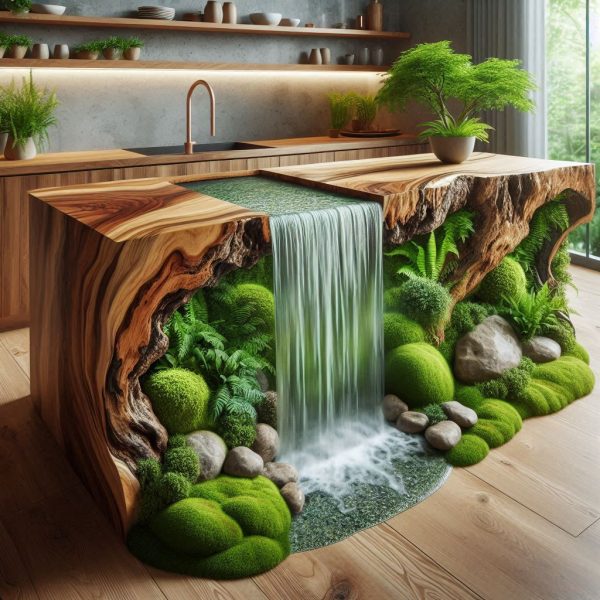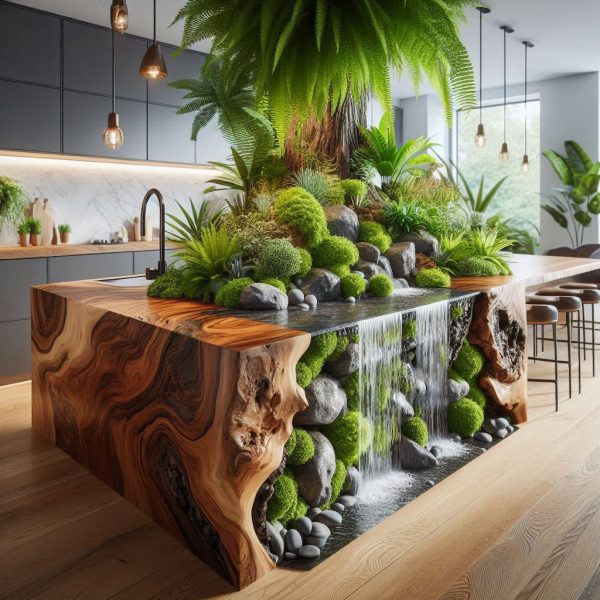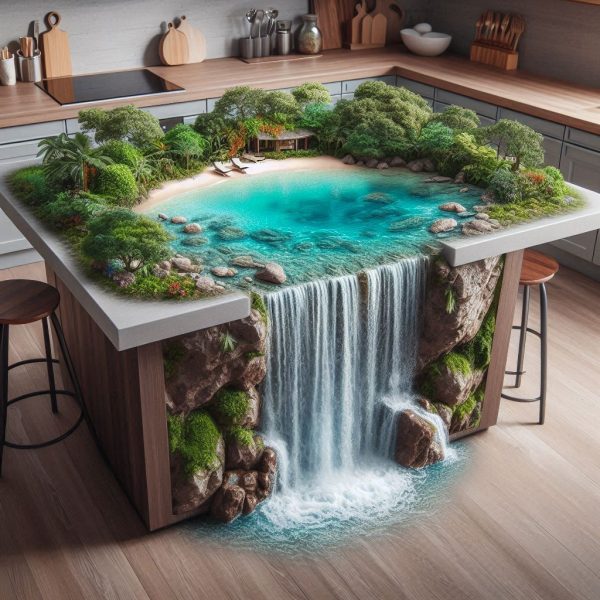In the ever-evolving world of interior design, kitchen spaces have become more than just areas for cooking; they are now the heart of the home, where functionality meets aesthetics. As a central feature of contemporary kitchens, islands serve as multifunctional spaces for cooking, dining, and socializing. Among the latest trends in kitchen design, Waterfall Kitchen Islands stand out for their sleek, modern appearance and their ability to make a statement in any kitchen.
The Waterfall Kitchen Island is a unique design where the countertop extends vertically down the sides, creating a continuous flow from the top to the ground. This design gives the impression of a “waterfall,” hence the name. Not only does it create a visually striking look, but it also enhances the kitchen’s overall functionality by adding additional surface space and a refined aesthetic.

In this comprehensive article, we will explore the rising popularity of Waterfall Kitchen Islands, their benefits, various material options, and how to incorporate them into different kitchen styles. Whether you’re renovating your kitchen or building a new home, this article will guide you through the possibilities of making the Waterfall Kitchen Island the centerpiece of your culinary space.
Contents
The Evolution of Kitchen Islands
From Practical to Stylish: The Changing Role of Kitchen Islands
Kitchen islands have been a staple in home design for decades. Initially, they were included primarily for their functional purposes, such as providing extra countertop space for meal preparation, offering additional storage, and even serving as an informal dining area. As time progressed, kitchen islands became more integral to the overall design of the space, transitioning from purely utilitarian to multifunctional pieces that also contribute to the kitchen’s aesthetic appeal.
In modern homes, kitchen islands often serve as a social hub where family and friends gather, making them a central design feature rather than an afterthought. As their role has expanded, designers have embraced more creative and innovative designs, and Waterfall Kitchen Islands have become one of the most sought-after styles in recent years.
The Birth of the Waterfall Edge
The Waterfall Kitchen Island is a contemporary twist on the traditional island design. Unlike standard islands, where the countertop ends at the edge of the cabinets, a waterfall island continues the countertop material down the sides, creating a seamless, elegant flow. This continuous material effect gives the island a sculptural quality, turning it into a statement piece within the kitchen.

The idea of a waterfall edge design originated from modern and minimalist design movements, where clean lines, simplicity, and a focus on materials are key elements. The waterfall edge not only adds visual drama but also allows homeowners to showcase high-quality materials, such as marble, quartz, or granite, which become the focal point of the kitchen.
Key Benefits of Waterfall Kitchen Islands
1. Aesthetic Appeal
One of the primary reasons homeowners and designers choose Waterfall Kitchen Islands is their undeniable visual appeal. The clean lines and seamless flow of the countertop material create a striking and sophisticated look. This design enhances the beauty of the natural stone or material used, making it the star of the kitchen.
Whether you choose a bold, veined marble for a dramatic effect or a sleek, matte quartz for a minimalist look, the waterfall edge elevates the overall aesthetic of your kitchen. It’s a feature that immediately draws attention and can serve as the focal point in both modern and transitional kitchen designs.
2. Durability and Protection
Beyond aesthetics, Waterfall Kitchen Islands offer practical benefits as well. The extended sides of the countertop act as protective shields for the cabinetry underneath. In high-traffic areas, such as kitchens where food preparation and gatherings take place, the waterfall edge provides additional durability and protection from scuffs, spills, and general wear and tear.

Materials such as quartz and granite are not only visually stunning but also highly durable, resistant to stains, and easy to clean. This makes the Waterfall Kitchen Island a smart investment, combining beauty with functionality for long-lasting use.
3. Added Functionality
A Waterfall Kitchen Island is more than just a design statement; it also serves practical purposes. The extended countertop provides extra space for meal preparation, and its sides can be used for seating arrangements, offering an informal dining area or a place for guests to gather while the cook works. This dual functionality makes the island a versatile element in any kitchen, maximizing both space and usability.
The waterfall edge also allows for creative storage solutions. Some designs incorporate cabinets or shelves into the sides of the island, keeping the clean, modern aesthetic while providing much-needed storage space for kitchen essentials.
4. Versatile Design Options
The versatility of the Waterfall Kitchen Island allows it to fit seamlessly into various kitchen styles, from ultra-modern to rustic chic. The choice of materials, colors, and finishes can drastically change the look and feel of the island, making it a customizable option for any homeowner. Whether you’re looking to complement a minimalist kitchen with a monochromatic quartz island or add warmth to a traditional space with a wooden waterfall edge, the possibilities are endless.

Material Choices for Waterfall Kitchen Islands
The choice of materials is crucial when designing a Waterfall Kitchen Island. Since the waterfall edge is a prominent feature, the material must be both aesthetically pleasing and durable. Here are some popular options:
1. Marble
Marble is a timeless and luxurious choice for a Waterfall Kitchen Island. Its natural veining and rich texture make it a stunning focal point in any kitchen. Marble’s elegance pairs well with both contemporary and traditional kitchen designs, offering a touch of opulence. However, it’s important to note that marble is a porous material, so it requires regular maintenance and sealing to prevent staining.
2. Quartz
Quartz is a popular choice for Waterfall Kitchen Islands due to its durability and low maintenance. Engineered quartz offers the beauty of natural stone but with enhanced strength and resistance to stains and scratches. Available in a wide range of colors and patterns, quartz is a versatile option that can complement any design style, from minimalist to industrial.
3. Granite
Granite is another durable and visually striking option for a Waterfall Kitchen Island. Known for its unique patterns and natural beauty, granite adds a sense of luxury to the kitchen. Like quartz, it’s highly resistant to heat, stains, and scratches, making it a practical choice for high-traffic kitchens. The natural variations in granite ensure that each Waterfall Kitchen Island is one of a kind.

4. Wood
For homeowners seeking a warmer, more organic feel, wood is an excellent choice for a Waterfall Kitchen Island. Whether it’s a rich walnut, rustic oak, or a more contemporary ash, wood brings a natural element to the kitchen. The waterfall edge highlights the grain and texture of the wood, creating a seamless transition from the countertop to the floor. While wood requires more maintenance than stone, it adds character and warmth to the kitchen.
5. Concrete
For an industrial or modern aesthetic, concrete is an unconventional yet stylish choice for a Waterfall Kitchen Island. Its raw, textured appearance makes it a bold statement piece. Concrete is also highly customizable, allowing for a range of finishes and colors. However, it’s essential to seal concrete properly to prevent staining and cracking over time.
Incorporating a Waterfall Kitchen Island into Different Kitchen Styles
1. Modern and Minimalist Kitchens
The Waterfall Kitchen Island is the perfect fit for modern and minimalist kitchen designs, where clean lines and simplicity are key. In these spaces, a monochromatic color palette, such as white quartz or gray concrete, can create a sleek, understated look. The continuous flow of the waterfall edge complements the minimalist aesthetic, keeping the space uncluttered and refined.
In a minimalist kitchen, less is more, so the Waterfall Kitchen Island serves as a functional yet visually impactful feature. Paired with streamlined cabinetry and minimalist lighting, the island becomes the central focus of the space.

2. Industrial Kitchens
In industrial-style kitchens, which often feature exposed brick, metal accents, and raw materials, a Waterfall Kitchen Island made of concrete or reclaimed wood can enhance the rugged, unfinished look. The waterfall edge adds a touch of sophistication to the otherwise utilitarian design, creating a balance between raw and refined elements.
The industrial kitchen often blends materials like metal and wood, so a wooden Waterfall Kitchen Island with metal accents could serve as the perfect centerpiece. The island not only adds warmth but also introduces a tactile element that contrasts with the cooler industrial features.
3. Rustic and Farmhouse Kitchens
For a rustic or farmhouse kitchen, a wooden Waterfall Kitchen Island is an excellent choice. The natural grain and texture of the wood bring warmth and charm to the space, while the waterfall edge creates a modern twist on traditional farmhouse design. Pairing the island with vintage-inspired fixtures, open shelving, and farmhouse sinks can create a cozy, inviting kitchen that blends old and new seamlessly.
4. Contemporary Kitchens
In contemporary kitchens, which focus on bold designs and innovative materials, a Waterfall Kitchen Island can make a striking visual impact. Materials like marble or high-gloss quartz are ideal for creating a luxurious, high-end look. The waterfall edge draws attention to the beauty of the material, making it the focal point of the kitchen.
Incorporating contrasting elements, such as a dark waterfall island against light cabinetry, can add depth and visual interest to the space. Contemporary kitchens often feature open layouts, allowing the Waterfall Kitchen Island to serve as both a functional workspace and a statement piece.

Practical Considerations for Installing a Waterfall Kitchen Island
While the Waterfall Kitchen Island offers numerous design and functional benefits, there are a few practical considerations to keep in mind during the planning and installation process:
1. Cost
Waterfall kitchen islands tend to be more expensive than traditional islands due to the additional material and labor required to create the waterfall edge. High-quality materials such as marble or granite can significantly increase the cost, but they also add long-term value to your home. It’s essential to budget accordingly and consider the investment as part of the overall kitchen design.
2. Space Requirements
The size of your kitchen plays a significant role in determining whether a Waterfall Kitchen Island is a practical option. These islands are best suited for larger kitchens, where there is ample space for the island to become the focal point. In smaller kitchens, the waterfall edge may make the space feel cramped, so it’s important to assess the layout and ensure there is enough room for the island to function efficiently.
3. Material Selection
Choosing the right material is crucial not only for aesthetics but also for durability. If you frequently use your kitchen for cooking and entertaining, opt for materials that are resistant to stains, scratches, and heat. Quartz and granite are excellent options for high-traffic kitchens, while wood may require more maintenance but offers a warm, inviting look.
Conclusion
A Waterfall Kitchen Island is the perfect combination of form and function, offering a stylish centerpiece that enhances the overall look and usability of your kitchen. With its seamless design, versatile material options, and ability to fit into a variety of kitchen styles, the Waterfall Kitchen Island is a top choice for homeowners and designers alike. Whether you’re drawn to the clean lines of a modern kitchen or the warmth of a rustic space, the waterfall edge adds an element of sophistication and timeless beauty to your home.

If you’re considering a kitchen remodel or new construction, a Waterfall Kitchen Island is a design feature that will not only impress but also provide years of functionality and enjoyment. From marble to wood, quartz to concrete, the material choices and design possibilities are endless. This stunning island design will elevate your kitchen to new heights, making it a space where style and practicality meet in perfect harmony.






